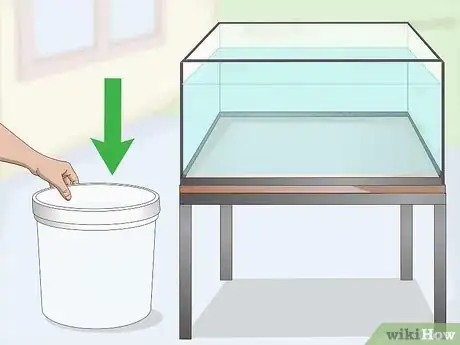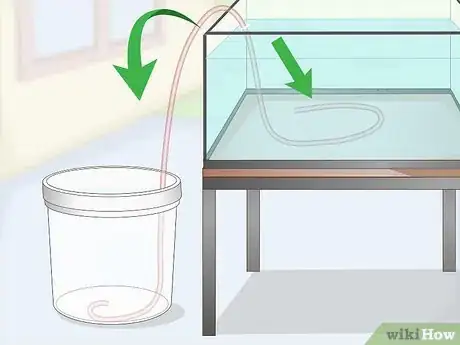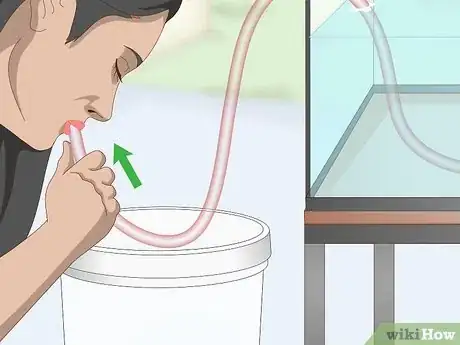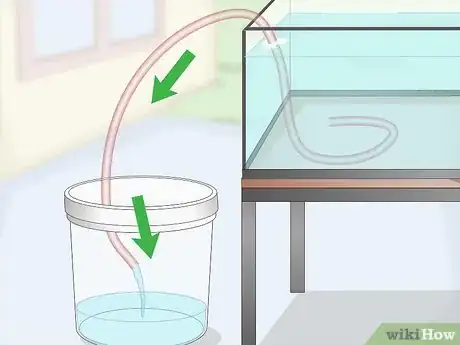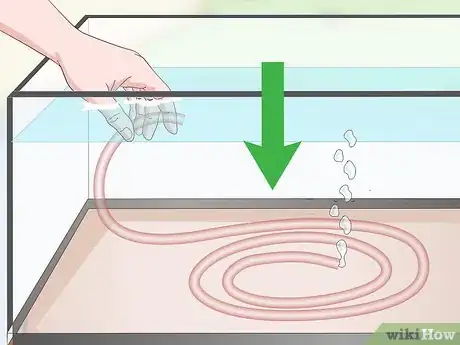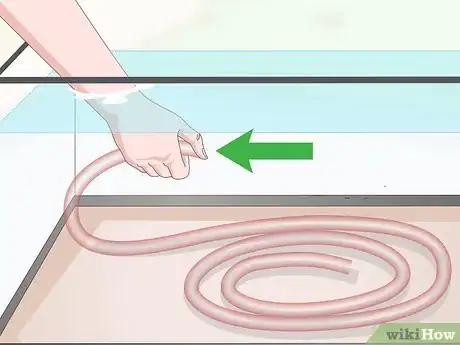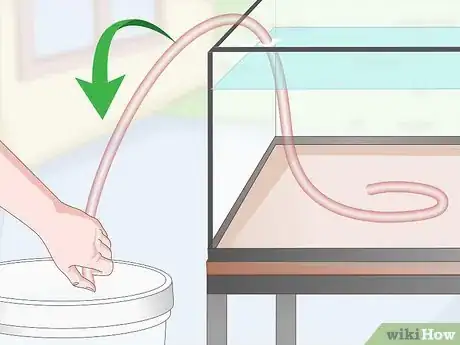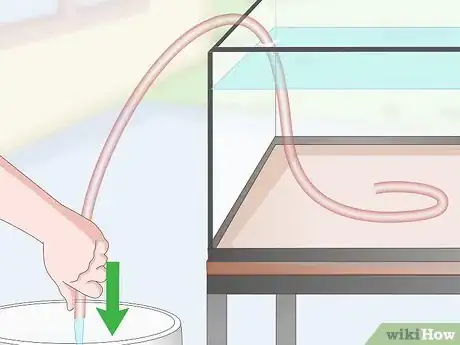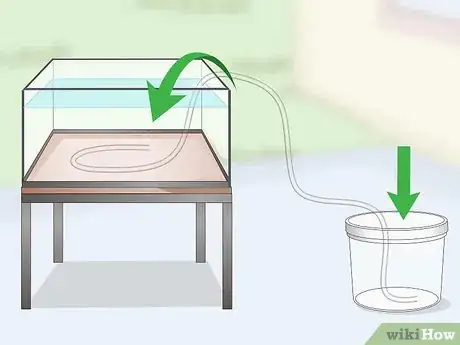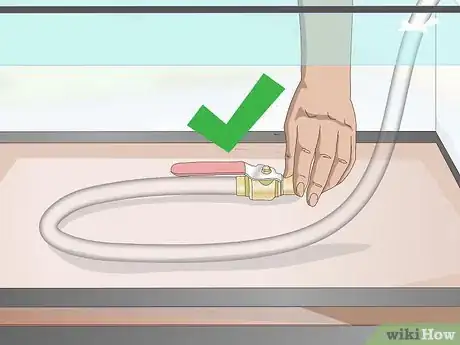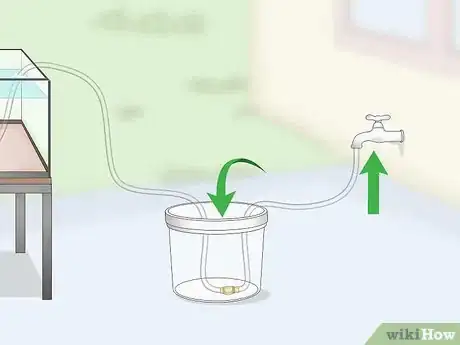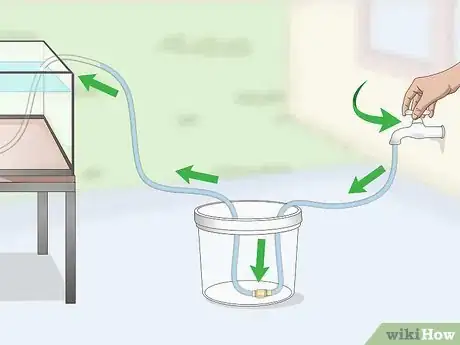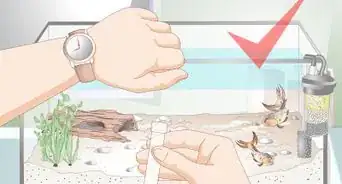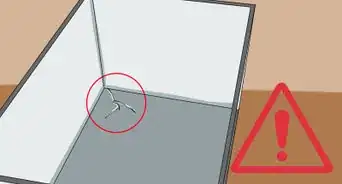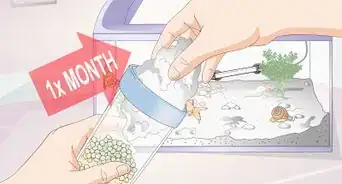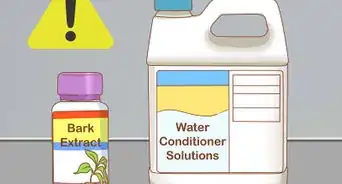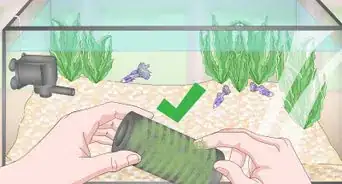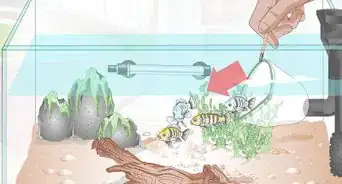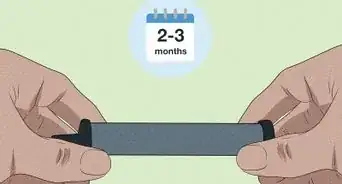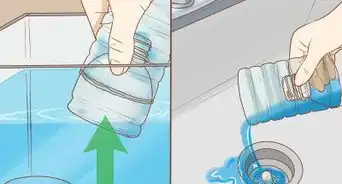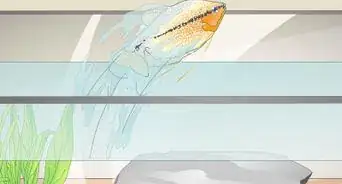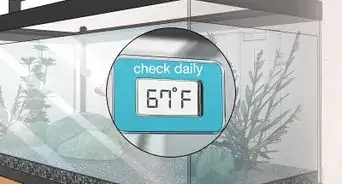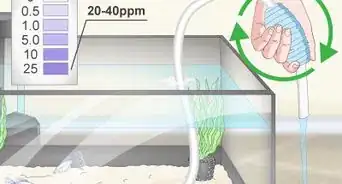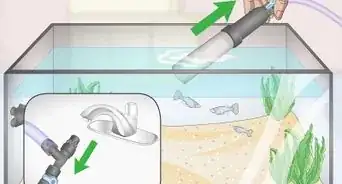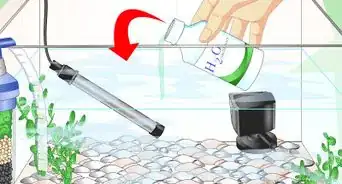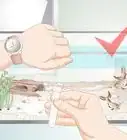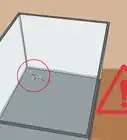This article was co-authored by Craig Morton. Craig Morton is the CEO of Aquarium Doctor Inc. based in Huntington Beach California and servicing Orange County, Los Angeles County, and the Inland Empire. With over 30 years of aquarium experience, Craig specializes in creating custom aquarium designs along with aquarium installation, service, and maintenance.
wikiHow marks an article as reader-approved once it receives enough positive feedback. In this case, several readers have written to tell us that this article was helpful to them, earning it our reader-approved status.
This article has been viewed 677,173 times.
Siphoning is a great way of using gravity to move large amounts of water from one location to another. You can empty a pool, clean a fish tank, or prepare rainwater jugs by siphoning. If you are working with fresh water, it’s possible to move water through a siphon using pressure from your mouth. If you are working with a single siphon tube, submerging the tube and draining it is a quick option. However, if you are tackling a larger job, then a two-hose siphon system might be your best bet.
Steps
Siphoning with Your Mouth
-
1Position an empty bucket. You’ll need to use gravity to siphon water from one spot into a bucket.[1] The object that the water is coming from must be higher than its final destination. So, if you are siphoning water from a full bucket to an empty bucket, place the destination bucket on a stable, lower surface.[2]
-
2Position a siphon tube. Stick the end of your siphon tube into the empty destination bucket.[3] It should almost reach the bottom of the bucket to prevent it from coming back out. Then, place the other end of the siphon into the full bucket.
- You may want to use a weight to keep the end of the hose in the water.
- You can use almost any type of hose or tube for siphoning. However, it really helps if the hose is clear so that you can see the progress of the water.
Advertisement -
3Suck lightly on the end of the tube. Pick up the end of the siphon tube from the lower destination bucket or container. Lift it just above the container of water, which will help you avoid getting water in your mouth. Then, place your lips around the tube's end and suck like a straw. Pull the water just over the rim of the container of water. Once the water reaches the arc of the tube, it will start to come down the tube. Move your mouth and insert the tube into the bucket.[4]
- If your hose isn't long enough for you to weigh it down in the water and hold it up over the container, then you likely need a bigger hose.
- Be careful to watch the location of the water in the tube or you might end up swallowing some as it comes out of the end. This is a reason why it is not a good idea to siphon other liquids, like gasoline, with your mouth.
-
4Let the water pour into the empty bucket. Take the end of the halfway full siphon tube away from your mouth and quickly place it into the lower container. The water will start to run into the bucket through the siphon. It will continue until the upper container is emptied or you pull the siphon end out of either container.
Siphoning by Submersion
-
1Immerse the tube in a container of water. Coil the siphon tube into a circle and place it into a container full of water. Gently push the tube down until it is completely covered, working from 1 end to the other. You will see air bubbles pop up to the surface of the water, as the air escapes from the inside of the tube. Go slowly to allow the air bubbles to escape as you submerge the tube. Once the bubbles stop, the tube is full of water and ready to be drained.[5]
- To make sure that the bubbles are completely out of the tube, shake it a bit before pulling it out.
-
2Place your finger over the end of the tube. Now that the tube is full of water, you’ll need to stop up the end that you plan to pull out of the container. Fold or crimp the tube in on itself toward the end, creating a barrier. Then, place your finger or thumb over the end, blocking off the flow of water out of the tube.[6]
- The tube must stay totally under the water during this process or you’ll end up with bubbles in it.
-
3Move the plugged end of the tube to the empty container. Slowly and carefully lift the blocked tube end out of the water. Keep your finger covering the end of the tube. And, make sure the other, unblocked end stays securely under the water. Place the blocked end into the lower, empty container.[7]
-
4Unplug the tube. Pull your finger away from the end of the tube. Hold the tube down slightly with your fingers to keep it from flailing around as the water starts to come out. Watch the water move from the higher container and into this new one. If the water flow seems to stall, give the tube a small, quick shake to start it up again.[8]
Siphoning with Two Garden Hoses
-
1Position the first garden hose. Put the end of your hose in the bottom of a higher container that the water will move out from. If you choose to anchor the hose down with an object to keep it from moving, just make sure that it doesn’t block the water flow. Then, place the opposite end of the same hose into a container that is the destination for the siphoned water.
- This is a great method to use if you need to siphon water over a longer distance or if you need to move a large amount of water.
-
2Attach the shut-off valve. Screw on the valve to the end of the hose that is at the bottom of the higher container. Make sure that the valve is set on the open position. You can purchase a shut-off valve at your local garden store.
-
3Attach a second hose. Get the unused hose and screw one of its ends into the empty side of the shut-off valve. Then, attach the other end of the second hose into a nearby faucet. Double-check that all of your connections are secure and tight.
-
4Fill the siphon hose. Turn your faucet until it starts to send water out through both hoses. Watch to see when the first hose is full. Then, turn the shut off valve into the off position. You can then disconnect the second hose from both the faucet and the valve. This will leave you with one hose that is full of water and connected to both containers.
-
5Open the shut-off valve. As soon as you move the valve into the open position, the water will rush out of the hose and into its final container. You can hold the end of the hold somewhat upright to guide the flow of water if you like.
Expert Q&A
Did you know you can get expert answers for this article?
Unlock expert answers by supporting wikiHow
-
QuestionCan I use a siphon hose to empty an aquarium?
 Craig MortonCraig Morton is the CEO of Aquarium Doctor Inc. based in Huntington Beach California and servicing Orange County, Los Angeles County, and the Inland Empire. With over 30 years of aquarium experience, Craig specializes in creating custom aquarium designs along with aquarium installation, service, and maintenance.
Craig MortonCraig Morton is the CEO of Aquarium Doctor Inc. based in Huntington Beach California and servicing Orange County, Los Angeles County, and the Inland Empire. With over 30 years of aquarium experience, Craig specializes in creating custom aquarium designs along with aquarium installation, service, and maintenance.
Aquarium Specialist, Aquarium Doctor Inc.
-
QuestionWhat's the best way to siphon water for an aquarium?
 Craig MortonCraig Morton is the CEO of Aquarium Doctor Inc. based in Huntington Beach California and servicing Orange County, Los Angeles County, and the Inland Empire. With over 30 years of aquarium experience, Craig specializes in creating custom aquarium designs along with aquarium installation, service, and maintenance.
Craig MortonCraig Morton is the CEO of Aquarium Doctor Inc. based in Huntington Beach California and servicing Orange County, Los Angeles County, and the Inland Empire. With over 30 years of aquarium experience, Craig specializes in creating custom aquarium designs along with aquarium installation, service, and maintenance.
Aquarium Specialist, Aquarium Doctor Inc.
-
QuestionHow do I empty an aquarium into a low-level sink using a piece of polythene tubing?
 Doug LudemannDoug Ludemann is the owner and operator of Fish Geeks, LLC, an aquarium services company based in Minneapolis, Minnesota. Doug has worked in the aquarium and fish-care industry for over 20 years, including having worked as a professional aquarist for the Minnesota Zoo and Shedd Aquarium in Chicago. He received his Bachelor of Science in Ecology, Evolution, and Behavior from the University of Minnesota.
Doug LudemannDoug Ludemann is the owner and operator of Fish Geeks, LLC, an aquarium services company based in Minneapolis, Minnesota. Doug has worked in the aquarium and fish-care industry for over 20 years, including having worked as a professional aquarist for the Minnesota Zoo and Shedd Aquarium in Chicago. He received his Bachelor of Science in Ecology, Evolution, and Behavior from the University of Minnesota.
Professional Aquarist Remove the substrate and detritus from one corner of the tank, then weight your tube down in that corner using a small stone or aquarium decoration. Start your siphon using the submersion method above. The size of the tube will depend on it's circumference, so a wider tube will go faster than a smaller tube. However, you can successfully drain a tank using a small tube if you're patient.
Remove the substrate and detritus from one corner of the tank, then weight your tube down in that corner using a small stone or aquarium decoration. Start your siphon using the submersion method above. The size of the tube will depend on it's circumference, so a wider tube will go faster than a smaller tube. However, you can successfully drain a tank using a small tube if you're patient.
Things You'll Need
- Container of water
- Plastic tube
- 2 garden hoses
- Shut-off valve
- Bucket
- Object to anchor the garden hose
Warnings
- Make sure that the hoses that you are using do not have any holes. If they leak water, then the siphon process may be slowed down or it may not work at all.⧼thumbs_response⧽
- It’s a good idea to have a separate hose for siphoning water. Do not use the same hose for gasoline products or chemicals.[10]⧼thumbs_response⧽
References
- ↑ Craig Morton. Aquarium Specialist, Aquarium Doctor Inc.. Expert Interview. 21 July 2020.
- ↑ https://beprepared.com/blog/14316/how-to-use-a-siphon-hose/
- ↑ Craig Morton. Aquarium Specialist, Aquarium Doctor Inc.. Expert Interview. 21 July 2020.
- ↑ http://www.firsttankguide.net/siphon-start.php
- ↑ https://beprepared.com/blog/14316/how-to-use-a-siphon-hose/
- ↑ https://beprepared.com/blog/14316/how-to-use-a-siphon-hose/
- ↑ http://www.firsttankguide.net/siphon-start.php
- ↑ https://beprepared.com/blog/14316/how-to-use-a-siphon-hose/
- ↑ http://sciencewithkids.com/Experiments/Physics-experiments/water-siphon-experiment.html
About This Article
To siphon water, start by submerging one end of a hose or tube in the water you want to siphon out. Then, put the other end in your mouth and gently suck in. When the water is about halfway through the tube, remove the tube from your mouth and put it into an empty container lower than the original water source. If you’re siphoning something other than water, like gasoline, use a clear hose and make sure to stop before the liquid reaches your mouth. Finally, let the water drain out, making sure the other end stays submerged in the water. For tips on how to move large amounts of water using two garden hoses, read on!
